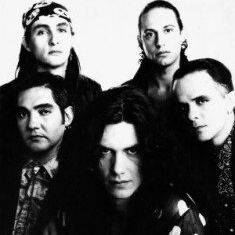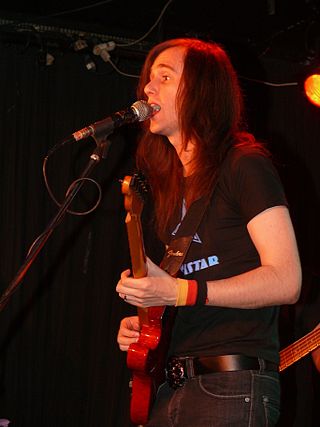
Carlos Humberto Santana Barragán is an American guitarist, best known as a founding member of the rock band Santana. Born and raised in Mexico where he developed his musical background, he rose to fame in the late 1960s and early 1970s in the United States with Santana, which pioneered a fusion of rock and roll and Latin American jazz. Its sound featured his melodic, blues-based lines set against Latin American and African rhythms played on percussion instruments not generally heard in rock, such as timbales and congas. He experienced a resurgence of popularity and critical acclaim in the late 1990s.

Gustavo Adrián Cerati Clarke was an Argentine musician, singer-songwriter and record producer, who gained international recognition for being the leader, vocalist, composer and guitarist of the rock band Soda Stereo. He is widely considered by critics, specialized press and musicians as one of the most important and influential artists of Latin rock. Billboard magazine ranked Cerati as the 33rd best rock singer of all time.

Carlos Alberto GarcíaMoreno, better known by his stage name Charly García, is an Argentine singer-songwriter, multi-instrumentalist, composer and record producer, considered one of the most important and avant-garde figures of Argentine and Latin American music. Named "the father of rock nacional", García is widely acclaimed for his recording work, both in his multiple groups and as a soloist, for the complexity of his music compositions, covering genres like folk rock, progressive rock, symphonic rock, jazz, new wave, pop rock, funk rock, and synth-pop. His lyrics are known for being transgressive and critical towards modern Argentine society, especially during the era of the military dictatorship, and for his rebellious and extravagant personality, which has drawn significant media attention over the years.

Caifanes is a Mexican rock band formed in Mexico City in 1986. The group achieved commercial success during the late 1980s and early 1990s. The original lineup of members consisted of Saúl Hernández, Sabo Romo (bass), Alfonso André (drums) and Diego Herrera. Alejandro Marcovich later joined as lead guitarist. Caifanes' style can be described as a hybrid of British new wave, progressive rock and Latin percussion underscored by deep, somber and Latin American-Mexican Spanish-influenced lyrics and the vocal style of Saúl Hernández. Members of Caifanes have cited The Cure, The Beatles and King Crimson as major influences. Adrian Belew produced their third studio album, El Silencio, and made a guest appearance on the track Piedra.
Argentine rock is rock music composed or performed by Argentine bands or artists mostly in Spanish.
Guaco is a tropical music band from Venezuela that was formed in Maracaibo by Mario Viloria, Alfonso "Pompo" Aguado, and Fernando Domínguez in 1968. Viloria, the main founder, retired to focus on his college studies; he was the group's main composer for several years. His home was also the main place where practices were held in the group's early years. The name Guaco is attributed a bird named "Guaco" that would fly over Viloria's house every morning. The band began as a gaita zuliana group, and during the 70s diverged from the traditional way of playing the genre by integrating it with elements of salsa music, and adding in violins and electric guitars which were very unusual instruments to be included in a gaita band. Today, the Guaco rhythm continues to evolve through a complex mixture of Gaita, Salsa, Pop music, Jazz, Funk and even Rock and Roll and Vallenato rhythms, concocting a recognizable and unique style that is considered to be a hallmark of the tropical music genre.

Doble Vida is the fourth studio album by Argentine rock band Soda Stereo, released on September 15, 1988. Produced by Carlos Alomar, this was the second of only 2 Soda Stereo albums produced by someone outside the musical group, with the other being Soda Stereo, the eponymous debut album produced by Federico Moura of Virus.

Soda Stereo was an Argentine rock band formed in Buenos Aires in 1982. The band's membership consisted of singer-guitarist Gustavo Cerati, bassist Zeta Bosio and drummer Charly Alberti. During their career, the band released seven studio albums before disbanding in 1997.

The 7th Annual Latin Grammy Awards were held for the first time in New York City, NY. The awards show was held at Madison Square Garden on Thursday, November 2, 2006. Shakira was the big winner winning Album of the Year, one of four awards that she won. She is the first female artist to win Record of the Year, Album of the Year, and Song of the Year.
Arco Iris were a rock group from the late 1960s until the late 1970s in Argentina, influential in Argentine rock history.
Alas was a mid-1970s, mostly instrumental progressive rock group in Argentine rock. They were also one of the major players in the tango-rock movement in Argentina during that period, alongside Rodolfo Mederos's group Generación Cero.

Pablo Sciuto is a Uruguayan musician, composer, poet and record producer born in the city of Montevideo, with twelve released albums where he combines rhythms like “Indie Pop”, Jazz, Bossa Nova and Candombe with an electronic sound. He's created a very particular style and has positioned himself in the wave of new creators of Rio de La Plata. At the present time Pablo lives in the city of Madrid, Spain since the year 2000.

La Marcha del Golazo Solitario Released in 1999 is the ninth studio album from the Argentine Ska Reggae Latin Rock band Los Fabulosos Cadillacs to reach gold.
Esteban Mellino was an Argentine actor best known for portraying the comical character Professor Diogenes Lambetain in the television series Badia y Cia, Fashion VIP and El humor de Cafe Fashion. Mellino had originally created his famous character during the 1980s for the productions of La Barra de Lambetain and Que merengue Lambetain.

Héctor Walter Giardino is an Argentine guitarist and the leader of the heavy metal and hard rock band Rata Blanca.

Mauricio "Moris" Birabent is an Argentine rock musician and pioneer of Spanish-language rock

Sebastian Schneider is a German Argentine guitar player, multi-instrumentalist, singer-songwriter and music producer. He began his career in the Argentine and Latin American rock scene playing in several rock bands and later began his solo career in 2004.

Félix Francisco Nebbia Corbacho, better known as Litto Nebbia is an Argentine singer-songwriter, musician and producer, prominent in the development of the early Argentine rock scene.

Almendra is the self-titled debut studio album by Argentine rock band Almendra which was released in 1969 on Vik, a subsidiary of RCA Victor. To distinguish it from the band's next release, Almendra II, it is also known as Almendra I. The album represented the first full-length musical endeavour of nineteen-year-old Luis Alberto Spinetta, having formed the band in the mid 1960s along with Emilio del Guercio, Edelmiro Molinari and Rodolfo García. The famous artwork, showing a crying man with a toy arrow stuck on his head, was designed by Spinetta to embody the different lyrical themes of the album.

"La balsa" is the debut single by the Argentine band Los Gatos, released on July 3, 1967 on Vik, a subsidiary of RCA Victor. Formed in 1967 after the disbandment of Los Gatos Salvajes, Los Gatos were the house band of the bar La Cueva, which became a popular meeting place for rock enthusiasts and the birthplace of Argentine rock—known locally as rock nacional. During the mid-to-late 1960s, Buenos Aires was experiencing a cultural blossoming characterized by innovations in modern art, literature and cinema, largely driven by a burgeoning youth subculture that adhered to the countercultural phenomenon of the decade. The underground had its center in La Cueva, Plaza Francia and the Torcuato di Tella Institute, and identified with British Invasion music. "La balsa" was written by Litto Nebbia—lead vocalist of the band—and Tanguito on May 2, 1967, in the men's toilet of La Perla de Once, another bar frequented by the group. At the time, Argentina was under a military dictatorship led by Juan Carlos Onganía, which regularly imprisoned and persecuted these young bohemians.














